
Support Team
Feedback:
support@nextpcb.comMany people are wondering what the future holds in this fast and changing technological development. Behind the highly developed technology, we are all enjoying, FPGA companies play a significant role in the field's advancement. They are, therefore, necessary for building up future IT systems and devices.
In this article, let us take a glimpse at these industry players. Know more about them, the role of FPGAs they are creating and their impact on our world these days and in the future. The future of our fast and constantly changing technology may be impossible to predict. However, as FPGAs become more widely used in various industries, we can see a positive outlook on their future.
This article may also help those considering diving into FPGA solutions. More than the information mentioned above, we will also cover what makes these Top 10 FPGA companies in the world where they are now to give you an idea of what to look for in other potential market players.
Let us start with a little bit of background.
A Field Programmable Gate Arrays, also known as FPGA, is an integrated circuit, a semiconductor device designed to be configured even after manufacturing with the desired functionality requirements or application of the customer.
As the name implies, they are made up of arrays of logic gates (AND, OR, XOR, and so on) that may be customized in the field. FPGA is based on a matrix of configurable logic blocks, CLB. Although it appears to be similar to microcontrollers and central processing units (CPUs), there is a substantial distinction.
A unique instruction set is used to program both microcontrollers and CPUs; however, the manufacturer seals the instruction set. Similar to how Application Specific Integrated Circuits (ASICs) work, it is developed and manufactured for specific jobs that cannot be changed after that. On the other hand, FPGA is programmable and re-programmable to do specific computational tasks utilizing Boolean equations or a Karnaugh map. This programmable memory has enabled users with more flexibility in modifying chip functionality in the field.
The man who introduced the first FPGA is Mr. Ross Freeman, an American inventor, electrical engineer and one of the official founders of Xilinx, now AMD Xilinx Inc. He worked as a Director of Engineering for the Components Division of a semiconductor manufacturing company.
The company he used to work for did not fully support his concept of a new hardware-programmable device. Hence, along with his colleagues, they founded their own company, Xilinx, in February 1984 and released the very first FPGA, XC2064, the following year, 1985. It is still one of the leading key players in the FPGA industry to date.
FPGAs are mainly used to design and test integrated circuits and electronic systems. The industry has revolutionized system design from the ground up by introducing programmable logic gates and configuration memory.
Currently, FPGAs are the preferred way to build complex systems with complex designs. FPGA-based systems can be used for tasks that require high performance or high reliability, such as military and aerospace applications, or for highly demanding tasks, such as data mining, financial modelling, machine vision, speech recognition, artificial intelligence (AI), or bioinformatics.
Many companies utilize FPGA because of their ability to process data faster than traditional processors. Companies use it for a variety of different tasks, including:
Flexibility: FPGAs provide an alternative to traditional hardware engineering techniques by allowing designers to implement any logical function without knowing the underlying hardware. It may be programmed and reprogrammed to meet current requirements, enabling you to offload resource-intensive operations to hardware, increasing its performance.
Because the functionality is not in the module itself but in the configuration, using FPGA allows you to be independent of component providers. This may be coded so that it can be performed on various FPGAs without any modifications.
Efficiency: Standard components frequently trade performance and compatibility to reach the largest feasible user group. FPGAs enable the development of systems precisely tuned to the intended function and operate seamlessly.
They are suited for use in time-sensitive systems. Unlike software-based solutions with real-time operating systems, FPGAs may provide clear indicators. Because of the flexibility, even complex computations may be completed in record time.
Timescale: FPGAs also enable designers to create systems with a much smaller time-to-market and less need for costly upfront design cycles.
The usage of FPGA considerably speeds up prototyping since the design of the IP cores is part of hardware engineering. It is feasible to do tedious functions such as commissioning and troubleshooting alongside development.
Cost efficiency: FPGAs are more cost-effective than ASICs for some applications. For example, the cost of an FPGA is about 20% of that of an ASIC with similar performance. One reason is that the design process is less expensive with FPGA than with ASICs. Its manufacturing costs can be lower because no mask costs are involved in fabricating FPGAs.
The FPGA industry is a global market and has a presence in all countries and regions. Currently, these FPGA companies dominate the field, with Altera (now Intel) and Xilinx (AMD Xilinx) topping the list. These two companies are the pioneer and leading manufacturers in the FPGA industry, along with the other FPGA companies listed below.
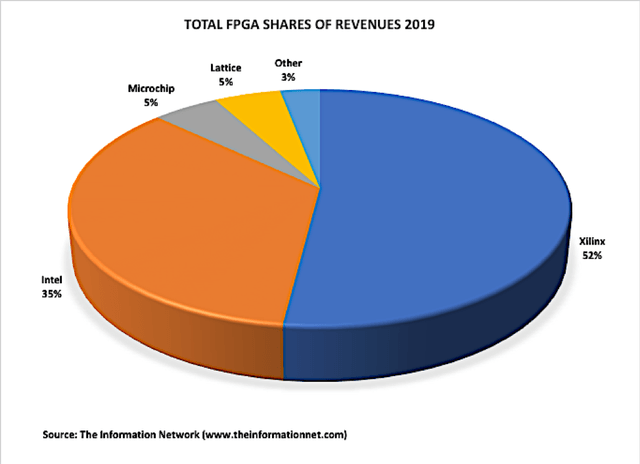
The Top 10 FPGA key players in the industry are the following:
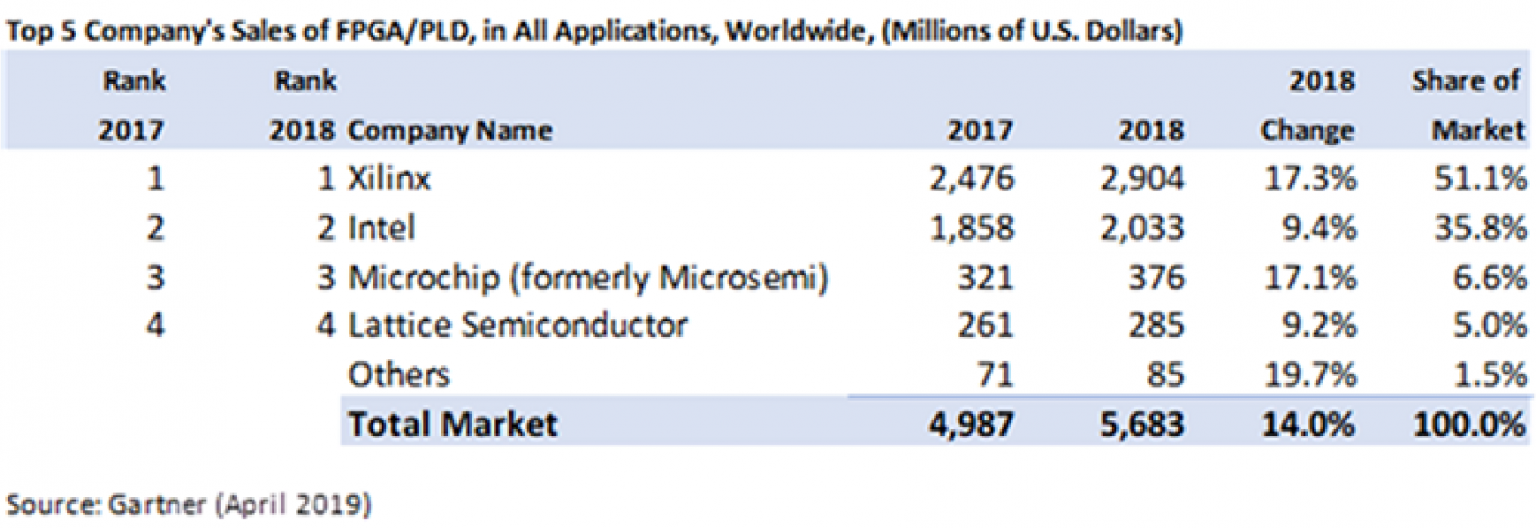
The company is the pioneer and one of the most popular FPGA manufacturers worldwide. With AMD’s acquisition, they created the industry's high-performance and adaptive computing leader. Their main headquarters is in San Jose, California.
AMD Xilinx provides a broad multi-node portfolio to meet the needs of a wide range of applications. They are known to cater to those who are into designing cutting-edge networking applications and to those who are into low-cost, small-footprint FPGAs.
Intel completed the acquisition of Altera last December 2015. Altera has had a long-running design partnership with Intel since 1984, just a year after their company was founded. It is now an Intel business unit known as Programmable Solutions Group (PSG).
Intel FPGAs provide a broad range of programmable embedded SRAM, high-speed transceivers, I/Os, logic blocks, and routing. Their built-in intellectual property (IP), paired with great software tools, is renowned for reducing FPGA production time, power, and cost.
Microchip Technology Inc. is a leading microcontroller and analog semiconductors provider for a broad range of customer applications worldwide. Their headquarters is in Chandler, Arizona, with offices in the US, Canada, Asia Pacific, the Middle East and Europe.
The company provides FPGA for logic integration to customers that want high speed, security, and volume. To expedite the design and simplify development. They also offer pre-built solutions for Digital Signal Processing (DSP), Serializer/Deserializer (SerDes), networking, microcontrollers (MCUs) and microprocessors (MPUs), and even analog blocks.
Lattice Semiconductor is an American semiconductor manufacturing company that designs and produces low-power, field programmable gate arrays (FPGA).
Designers may use Lattice FPGA to accelerate innovation and save production time in a variety of applications, including communications, computation, automotive, and industrial.
The firm is an American fabless semiconductor company based in Santa Clara, California, with an additional R&D unit in Bangalore, India, and a sales office in Shenzhen, China.
Achronix Semiconductor provides high-performance FPGA solutions, embedded FPGA (eFPGA) products, system-level solutions, and supporting design tools.
QuickLogic is a fabless semiconductor firm. They build a full-stack platform for artificial intelligence (AI), speech, and sensor processing.
The company develops a comprehensive artificial intelligence (AI), voice, and sensor processing platform. In addition to pASIC3 and QuickRAM FPGA families, they also offer programming hardware and design software. It also has an IP business that licenses its eFPGA technology to other companies for use in their SoCs.
Efinix is a multinational company with offices in several countries. Their investors are a diverse group of high-tech semiconductor and system manufacturers that found value in the firm's Quantum architecture.
They are one of the industry leaders in programmable platforms that accelerate advancements in artificial intelligence, edge computing, compute acceleration, and custom logic. The company’s key technology is the Quantum programmable fabric, which significantly improves Power-Performance-Area over conventional FPGAs. Efinix devices serve a wide array of applications, ranging from simple consumer items to I/O-intensive interfaces to comprehensive system solutions.
The company's EFLX-embedded FPGA IP allows any semiconductor design to adapt to changing protocols, standards, algorithms, and customer requirements. They also enable designers to construct reconfigurable accelerators that boost essential workloads 30-100 times faster than standard processors.
The company was founded in 2014 and is located in China, aiming to expedite customer innovation through programmable solutions. They optimize items and eliminate limitations for PLD users. Their drive to technology and quality helps companies minimize costs by deploying FPGA on production boards. They provide programmable logic devices, design software, IP cores, reference designs, and development kits.
S2C is the worldwide field leader in FPGA prototype solutions for modern cutting-edge SoC/ASIC designs. The company has successfully delivered quick SoC prototype solutions since 2004, with sales offices across the United States, Europe, Israel, China, Hong Kong, Korea, Japan, and Taiwan.
There are many FPGA manufacturers out there, and they usually have a regional focus. The Asia Pacific has the largest FPGA market share and will still be in the years to come. The most significant contributor to this is the rise of 5G telecommunication network deployment and the expansion of hyperscale and cloud data centers in the Asia Pacific region.
One particular country in the region, China, manufactures and uses FPGAs across the country. It has more than 290 semiconductor wafer fabrication, IC testing, and packaging plants. These facilities have various equipment with integrated FPGAs to improve functionality, thus, reducing time and development costs.
Also, China’s number one ranking in motor vehicle production in the region has a significant role in the growth of the FPGA industry. The increase of applications in the automotive field, like networking and connectivity systems, infotainment and the wider use of e-vehicles and charging stations deployment added and opened more opportunities in the field.
Asia Pacific region holds the largest FPGA market share from 2022 to 2027. It is likely to dominate the field throughout this period.
The historical report and forecast in the Asia Pacific region below:
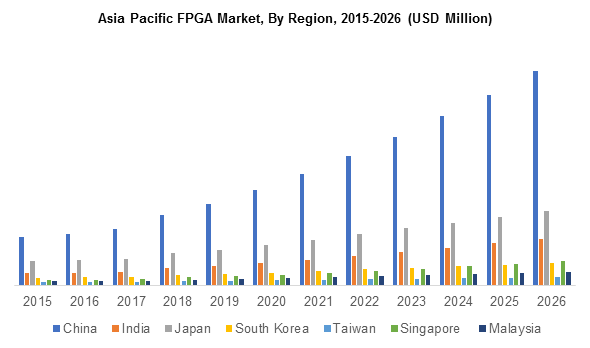
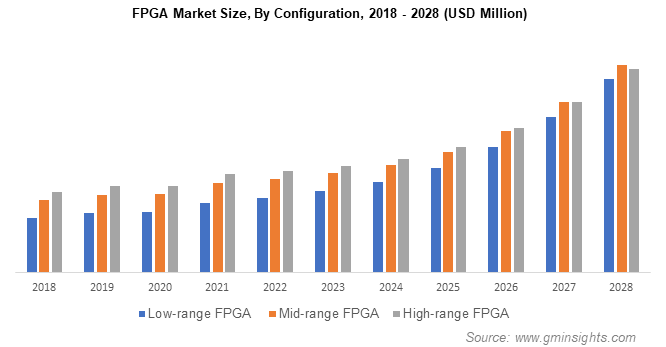
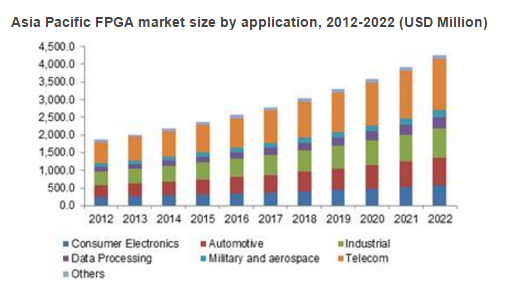
There are many FPGA companies in the field, but it can be challenging to find a good one. Before investing in an FPGA company, it is essential to consider which criteria are most important, as one company may be much better for specific projects than another.
It is important that all agreed plans are feasible and will be executed effectively. It may be advantageous to investigate the company's financial statements before investing. You should also determine if the company has sufficient resources and a management team with experience in innovation for advancing and boosting your product.
There are many different things to consider when looking for good FPGA companies. Here are some metrics you should consider once you are ready to dive into the great possibilities of FPGA.
Vendor products may seem identical, but if you examine the various FPGA product offerings from different vendors, you will see the difference. Some FPGA companies have additional clock signals or specific blocks that might give you an advantage. Certain FPGAs are better designed for a high-speed interface; hence, analyzing your FPGA needs and categorizing them is crucial.
Look for FPGA companies that offer fast and reliable products, especially when you need to purchase in bulk without compromising the quality.
Find a company that offers quality assurance with highly skilled employees who are experts in their fields and with the latest technologies. Some vendors have a local representative and support team that may assist you with your design. A competent and supportive representative may help you speed up your design timetable.
It would also help to look for a company that provides technical support to its customers. The company should have a dedicated customer service team available to offer instant assistance in case of emergencies.
Filter FPGA companies that offer warranties on their products and services, as it will help ensure years of smooth and safe operation.
Cost is most likely a major consideration in your decision-making process. FPGA costs are mostly available and published online. The price of the chips varies by FPGA companies and the type of chip itself. Some FPGA chips cost more than $1 million, while others might be as low as $50.
You should always look for a company that offers competitive pricing and is willing to work with your budget. A company that offers honest pricing, which means you will know the total cost of their services right from the very start. You may try to haggle and strike a deal that fits your budget.
The FPGA market size surpassed USD 6 billion in 2021, and industry experts project it to expand at a CAGR of over 12% from 2022 to 2028. Increasing adoption of artificial intelligence (AI) and machine learning (ML) technologies for edge computing applications in data centers is driving FPGA expansion.
You can find FPGAs in a wide range of industries, just about everywhere, from medicine to defense.
FPGAs play a key role in 5G networks since they provide the increased flexibility and efficiency needed to address the rising and constantly changing demand for 5G wireless connectivity.
With FPGA's programmable nature, they suit best in a variety of sectors across the globe. Below is a list of the application in different business segments.
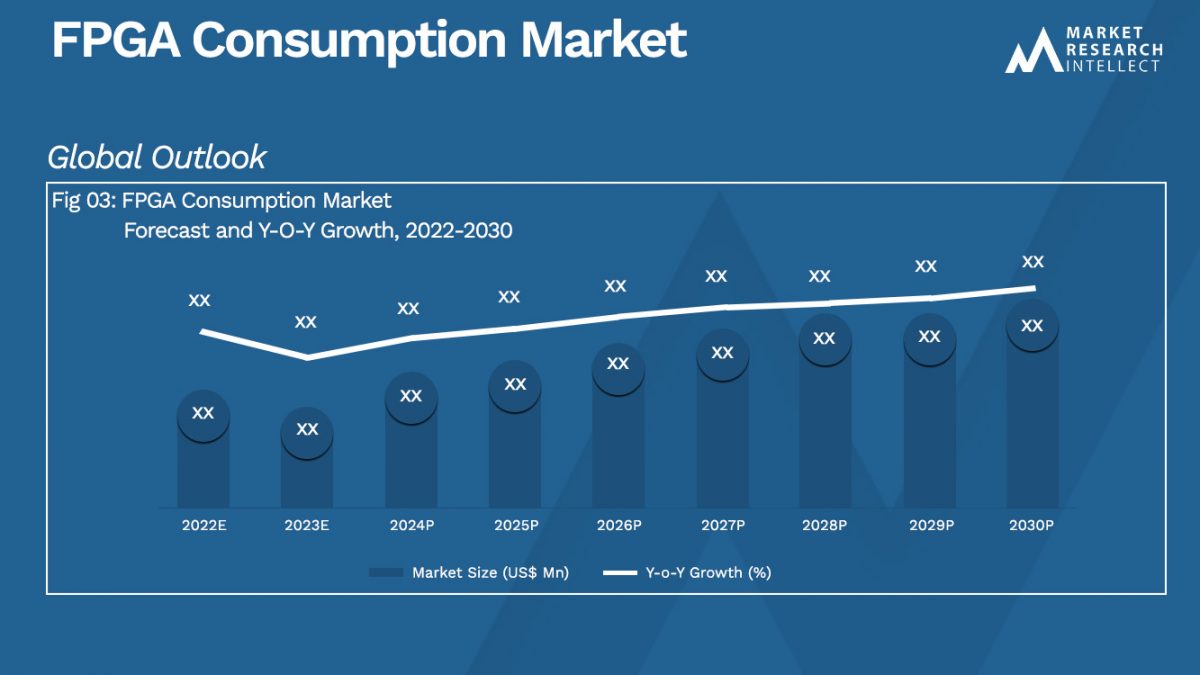
The FPGA industry is now growing in terms of product sophistication, as they can help accelerate the performance of a system. They are used primarily in embedded systems and are now gaining popularity in data centers.
Demand for FPGA components surged in the latter half of 2021 as industrial activity expanded and the usage of telecommunications, automotive goods, data centers, and electronic gadgets increased. In addition, many companies are focusing on setting up factories in new geographical regions to reduce the risk associated with supply chain disruptions in the event of a crisis; think about what happened at the height of the COVID-19 pandemic.
Currently, there is a significant skill shortage in this field, and the trend of future development is highly promising. Because FPGAs are employed in various companies in different sectors, the growing industry has a greater demand for competent engineers for a variety of market segments, including telecommunications, automotive, products, industrial, military and aerospace, and data processing.
It is a good idea to take advantage of this while the industry is still not saturated. Notably, future technological and industrial development trends are more crucial than this status quo. The potential of FPGAs is still underestimated, looking from the standpoint of industrial development trends, and there is more work and advancements in the future.
The future of FPGA technology is looking very promising. With the new advances in tailored-made models and algorithms, we can expect FPGAs to provide better performance than other platforms. Notably, the present development trend of artificial intelligence algorithm models goes from training to inference, which is ideal for the future development of FPGAs.
We can also expect FPGA to play a central role in military and aerospace applications. In addition, the use of FPGAs in oil and gas is growing at a rapid pace.
FPGA technology has been gaining a following and demand due to the several advantages it provides. They are practical in the long term and work with many design paradigms, including digital, analog, mixed-signal, and others.
We can expect the industry to grow steadily in the coming years as pressure from the ASIC leads to a return to FPGA technology. eFPGA technology is generic and works like an off-the-shelf FPGA chip bringing logic reconfigurability to ASIC and SoC.
Algorithms for artificial intelligence are rapidly and constantly changing. While ASIC chips provide the highest performance in terms of utilization, speed, and low power consumption, AISC development is risky. A big market is necessary to ensure cost-effective prices, in addition to the duration process from R&D to market that is so long, that it is unviable for areas where algorithms rapidly evolve. Because of the cost and risk associated with ASIC chips, only a few companies, like Google, are willing to take the risk.
With the rising telecom infrastructure development in Asia Pacific and Africa, we can expect the demand for FPGAs to grow. Key players in the industry are investing in technological advancements, consequently driving market growth.
We also see the FPGA security market reach US$ 1,573.6 million by 2027 from US$ 736.8 million in 2019. Reports show an estimated compound annual growth rate of 11.4%; hence, we are expecting the field programmable gate array share to reach USD 25.85 billion by 2030, with an average CAGR of 11.2% from 2020 to 2030.
We will witness significant growth in the region, owing to the rising adoption of FPGAs in various applications, such as electronics, automotive, aerospace and defense, and industrial. Moreover, the increasing number of data centers and cloud service providers in the region will likely drive the demand for FPGAs.
FPGA, or Field Programmable Gate Array, is very popular in the market these days. It offers a high-performance processing chip that you can configure after manufacturing to accelerate the performance of software applications. You can program them to perform tasks that need high performance or reliability for different industries. These may include computer graphics, industrial automation, military systems, medical devices and equipment, electronics, robotics, aerospace, communications networks, wireless technologies, etc.
FPGA companies are a key part of the semiconductor industry and have a significant impact on the computing industry. Knowing more about the top 10 industry players and learning what brought them to their current market standing gives you an idea of what makes a reputable FPGA company.
You may use those metrics once you are ready to explore the exciting possibilities that FPGAs provide. As the FPGA technology industry grows, you may see great potential in other industry players.
The metrics discussed earlier should also help you gauge whether such a company is truly promising or just merely making empty promises. Areas to consider before you choose an FPGA manufacturer is their financial standing, their resources and management team, product delivery, price and quality, customer service and sales support and warranty/guarantee.
Moving forward, expect Asia Pacific to be a key market for the growth of the FPGA industry due to the emergence of innovative FPGA based products and the growing demand for electronics. We expect it to grow notably in the future years due to the rising telecom infrastructure development in the region. A number of APAC countries are investing heavily in the telecom sector, thereby driving the demand for FPGAs. Furthermore, the presence of key industry players and technological advancements are also fueling FPGA growth.
Still, need help? Contact Us: support@nextpcb.com
Need a PCB or PCBA quote? Quote now